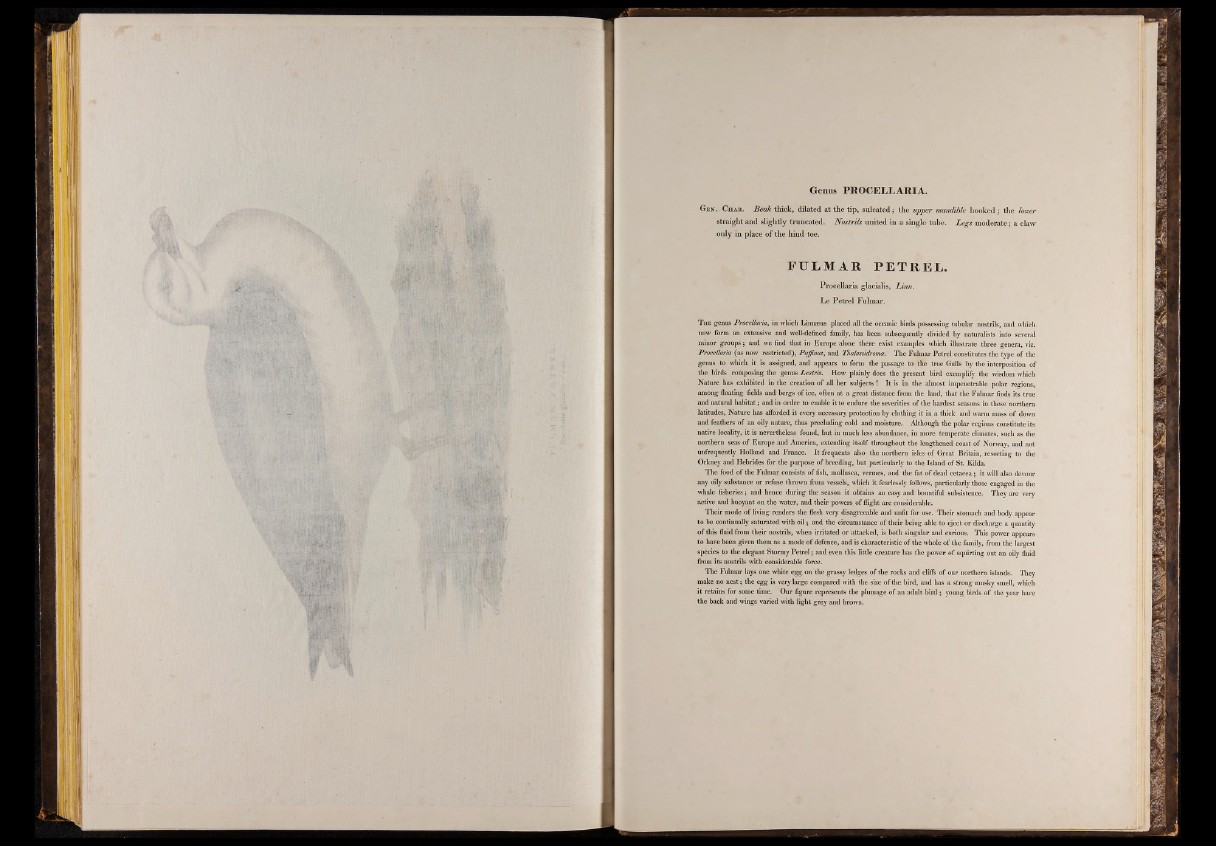
Genus PROCELLARIA.
G en . C har. Beak thick, dilated at the tip, sulcated; the upper mandible hooked ; the lower
straight and slightly truncated. Nostrils united in a single tube?. Legs moderate; a claw
only in place of the hind toe.
F U LMA R P E TRE L .
Procellaria glacialis, Linn.
Le Petrel Fulmar.
T he genus Procellaria, in which Linnaeus placed all the oceanic birds possessing tubular nostrils, and which
now form an extensive and well-defined family, has been subsequently divided by naturalists into several
minor groups; and we find that in Europe alone there exist examples which illustrate three genera, viz.
Procellaria (as now restricted), Puffinus, and Thalassidroma. The Fulmar Petrel constitutes the type of the
genus to which it is assigned, and appears to form the passage to the true Gulls by the interposition of
the birds composing the genus Lestris. How plainly does the present bird exemplify the wisdom which
Nature has exhibited in the creation of all her subjects ! It is in the almost impenetrable polar regions,
among floating fields and bergs of ice, often at a great distance from the land, that the Fulmar finds its true
and natural habitat; and in order to enable it to endure the severities of the hardest seasons in these northern
latitudes, Nature has afforded it every necessary protection by clothing it in a thick and warm mass of down
and feathers of an oily nature, thus precluding cold and moisture. Although the polar regions constitute its
native locality, it is nevertheless found, but in much less abundance, in more temperate climates, such as the
northern seas of Europe and America, extending itself throughout the lengthened coast of Norway, and not
unfrequently Holland and France. It frequents also the northern isles of Great Britain, resorting to the
Orkney and Hebrides for the purpose of breeding, but particularly to the Island of St. Kilda.
The food of the Fulmar consists o f fish, mollusca, vermes, and the fat of dead cetacea; it will also devour
any oily substance or refuse thrown from vessels, which it. fearlessly follows, particularly those engaged in the
whale fisheries; and hence during the season it obtains an easy and bountiful subsistence. They are very
active and buoyant on the water, and their powers of flight are considerable.
Their mode of living renders the flesh very disagreeable and unfit for use. Their stomach and body appear
to be continually saturated with oil; and the circumstance of their being able to eject or discharge a quantity
of this fluid from their nostrils, when irritated or attacked, is both singular and curious. This power appears
to have been given them as a mode of defence, and is characteristic of the whole of the family, from the largest
species to the elegant Stormy Petrel; and even this little creature has the power of squirting out an oily fluid
from its nostrils with considerable force.
The Fulmar lays one white egg on the grassy ledges of the rocks and cliffs of our northern islands. They
make no nest; the egg is very large compared with the size of the bird, and has a strong musky smell, which
it retains for some time. Our figure represents the plumage of an adult bird; young birds of the year have
the back and wings varied with light grey and brown.